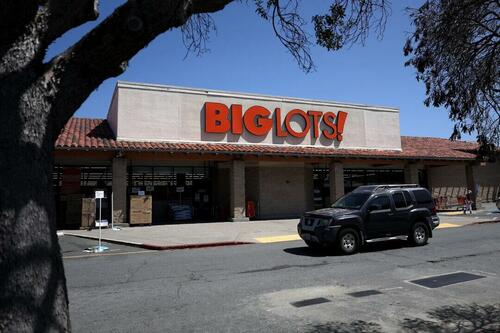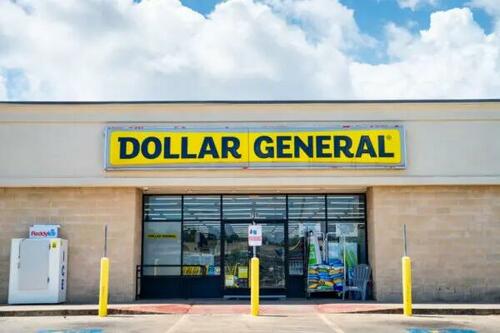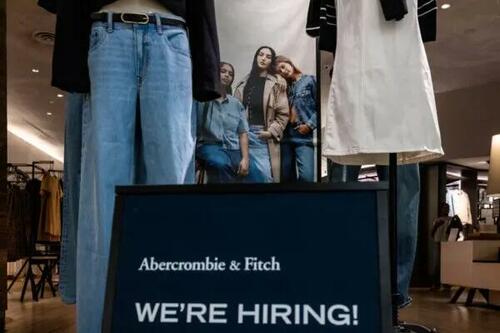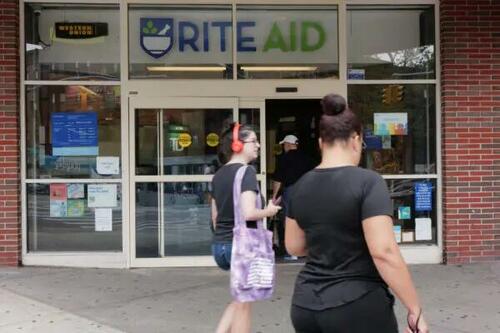
More High-Profile Retail Stores Are Getting Kicked In The Teeth
Authored by Mark Gilman via The Epoch Times (emphasis ours),
Lackluster consumer confidence is negatively affecting discount retailers such as Dollar General and Big Lots. Dollar General’s shares dropped 32 percent on Aug. 29 after the company admitted in its earnings report that lower-income customers are still struggling, while Big Lots’s fortunes are in a tailspin.
 A sign is posted in front of a Big Lots in Hercules, Calif., store on June 7, 2024. Justin Sullivan/Getty Images
A sign is posted in front of a Big Lots in Hercules, Calif., store on June 7, 2024. Justin Sullivan/Getty ImagesMiddle-scale retailer Abercrombie & Fitch, which made a significant comeback in 2024, saw its stock drop 15 percent this week, while drugstore chain Rite Aid has emptied up to 500 stores amid its bankruptcy filing.
National Retail Federation (NRF) chief economist Jack Kleinhenz wrote in its August monthly review that while the U.S. economy appears healthy, consumers are skeptical. “While the overall economy continued to display remarkable strength in the first half of 2024, consumer confidence remains weak,” he said.
That sentiment was bolstered by the latest University of Michigan’s monthly survey in July, which fell for the fourth month in a row. Dr. Joanne Hsu, who authored the report, wrote: “Sentiment has lifted 33 percent above the June 2022 historical low, but it remains guarded as high prices continue to drag down attitudes, particularly for those with lower incomes.”
 The exterior of a Dollar General convenience store on August 30, 2024 in Austin, Texas. Dollar General stock fell 32% after cutting its full-year outlook. The drop is the company’s largest on record. Photo by Brandon Bell/Getty Images
The exterior of a Dollar General convenience store on August 30, 2024 in Austin, Texas. Dollar General stock fell 32% after cutting its full-year outlook. The drop is the company’s largest on record. Photo by Brandon Bell/Getty ImagesIn Dollar General’s case, the discount store reported it expects fiscal 2024 same-store sales to be up 1.0–1.6 percent, lower than its prior outlook for a 2.0–2.7 percent increase, with earnings per share for the year expected to be in the range of just $5.50–6.20. That prediction was below its original forecast of $6.80–7.55 per share. Dollar General’s core consumer base comprises households earning less than $35,000 annually, contributing to 60 percent of overall sales.
On the company’s post-earnings call, Dollar General CEO Todd Vasos said, “While middle and higher-income households are seeking value as well, they don’t claim to feel the same level of pressure as low-income households, as customers have felt more pressure on their spending.” He added that what he is seeing in the numbers “would indicate that this is a cash-strapped consumer, even more than we saw in the first quarter.”
Meanwhile, another discount retailer, Big Lots, is struggling in this economy. In its June filing with the U.S. Securities and Exchange Commission, Big Lots reported that 244 of its 1,392 stores are underperforming and planned to close 35 to 40 of them. Its net sales ended in May this year dropped 10 percent year over year ($415 million), to a little over $1 billion. The company also announced it owed another $72.2 million in debt, accounting for a total of $573.8 million.
 The exterior of a Dollar General convenience store on August 30, 2024 in Austin, Texas. Dollar General stock fell 32% after cutting its full-year outlook. The drop is the company’s largest on record. Photo by Brandon Bell/Getty Images
The exterior of a Dollar General convenience store on August 30, 2024 in Austin, Texas. Dollar General stock fell 32% after cutting its full-year outlook. The drop is the company’s largest on record. Photo by Brandon Bell/Getty ImagesIn a press release, Big Lots President and CEO Bruce Thorn wrote: “While we made substantial progress on improving our business operations in the first quarter, we missed our sales goals due largely to a continued pullback in consumer spending by our core customers, particularly in high-ticket discretionary items. We remain focused on managing through the current economic cycle by controlling the controllables. As we move forward, we’re taking aggressive actions to drive positive comp sales growth in the latter part of the year and into 2025 and to maintain year-over-year gross margin rate improvements, all driven by progress on our five key actions.” The company’s second-quarter results will be announced on Sept. 6.
Neil Saunders, the managing director of GlobalData Retail, told Modern Retail, “It doesn’t look as if they are going to be able to stop the bleeding anytime soon. The financials are going in the wrong direction. This is a business that has suffered sales declines for a reasonable period of time, and what you come to expect is that, as you go forward, those declines start to moderate a bit and then you start to go back into growth, but Big Lots shows no signs of that happening.”
Comeback darling Abercrombie & Fitch saw its stock rise 21 percent in the second quarter this year, but immediately drop 15 percent after CEO Fran Horowitz used the word “uncertain” in his earnings analysis. “We delivered a strong first half of the year, and we are increasing our full-year outlook. Although we continue to operate in an increasingly uncertain environment, we remain steadfast in executing our global playbook and maintaining discipline over inventory and expenses,” he said.
In the University of Michigan report, Dr. Hsu said one of the worries consumers now have is stagnant wage growth. “While consumers exhibited confidence that inflation will continue to soften, many expressed concerns about the effect of high prices and weakening incomes on their personal finances, she wrote.
According to the Bureau of Labor Statistics’ latest Job Openings and Labor Turnover Survey, the three-month average for payroll gains slowed to 177,000 in June, down from 267,000 in March. As of June 30, the bureau reported the number of job openings was unchanged at 8.2 million, but compared negatively by nearly one million (941,000) compared to June 2023. Hiring also fell from 5.7 million jobs in May this year to 5.3 million in June.
 A hiring sign is displayed in front of Abercrombie & Fitch at the Tysons Corner Center mall on August 22, 2024 in Tysons, Virginia. According to reports, over 800,000 fewer jobs were created within the U.S. economy than originally reported in the 12-month period, 30% less than the previously reported 2.9 million from April 2023 through March, 2024. Photo by Anna Rose Layden/Getty Images
A hiring sign is displayed in front of Abercrombie & Fitch at the Tysons Corner Center mall on August 22, 2024 in Tysons, Virginia. According to reports, over 800,000 fewer jobs were created within the U.S. economy than originally reported in the 12-month period, 30% less than the previously reported 2.9 million from April 2023 through March, 2024. Photo by Anna Rose Layden/Getty ImagesBut she added that even though inflation has slowed, higher prices continue to make an impact on consumer sentiment. “Over the past two years, our surveys clearly reveal that consumers distinguish between their experiences with high price levels and their views of overall inflation rates,” she writes. “On one hand, they recognize that inflation has softened substantially and expect that trend to continue. On the other hand, slowing inflation does not generally lead to reductions in overall price levels; the persistence of high prices continues to exert pain on household budgets.”
 A Rite Aid store stands in Brooklyn on August 28, 2023 in New York City. Rite Aid, a national chain retail pharmacy and convenience store with thousands of locations across the country, is preparing to file for Chapter 11 bankruptcy as it faces increasing financial stress related to opioid lawsuits and other financial pressures. Photo by Spencer Platt/Getty Images
A Rite Aid store stands in Brooklyn on August 28, 2023 in New York City. Rite Aid, a national chain retail pharmacy and convenience store with thousands of locations across the country, is preparing to file for Chapter 11 bankruptcy as it faces increasing financial stress related to opioid lawsuits and other financial pressures. Photo by Spencer Platt/Getty ImagesAnother retail casualty this year has been the sudden bankruptcy of Rite Aid, leaving hundreds of stores empty in states such as Michigan and Ohio after closing up to 500 stores nationally. In its filing, the company said it expected its losses would increase significantly in the past quarter, following a loss of $750 million between March 2022 and March 2023 and another $307 million in the second quarter this year. The last quarterly report filed by Rite Aid was in June, when they had only $135.5 million of cash to work with, combined with $3.3 billion in long-term debt.
According to the NRF monthly review, though overall consumer spending is still inching upward, it’s going to non-retail areas of the economy. “Overall consumer spending continues to be dominated by travel, entertainment and “experiences,” the NRF wrote in its report.
Tyler Durden
Sun, 09/01/2024 – 11:40

 1 rok temu
1 rok temu










![Zderzenie na Piłsudskiego. Uszkodzone 5 aut [FOTO]](http://codziennikmlawski.pl/wp-content/uploads/2025/11/b0777bcb-acaa-4ae4-b5f3-41457eaffebc.jpg)